Practical tips
| Climbing harnesses are actually quite simple pieces of equipment, easy to use and quite safe if used correctly. But your life hangs on your harness, which is why you should always make sure that you use it in the correct manner. A safety routine will help you to avoid mistakes. | |
| Checking the buckles | |
|---|---|
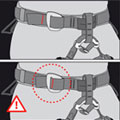
|
Always check the buckles when you have put the harness on to make sure they are correctly connected and closed. Double-pass buckles are only safe if they have been doubled back. A «Danger Stamping» on Mammut harnesses acts as a reminder should you forget. A sufficient amount of closure webbing must stick out the other side of the buckle, just as in a knot on the end of a rope. With all Mammut harnesses, a stitch in a contrasting color shows if you have enough extra. Check adjustable leg loops to see that they are sitting correctly and that the buckles have been threaded correctly. |
| Tying in | |
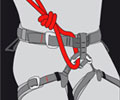
|
Always tie yourself directly to the rope; do not use carabiners, which
will put an unsafe element into the system. Thread the rope through
both tie-in loops: on the waist band and also on the base of the leg
loop. This gives redundancy, as the rope is attached through two points,
and also gives a better hanging position.Mammut has developed the Tie-in
Protector to prevent the base of the leg loop from wearing out. The«belayloops»
will of course hold 15 kN in accordance with safety standards, but due
to abrasion and age, they can lose strength; if this part fails it could
potentially be fatal. It should be used when clipping on any rappell
or belay devices, but the seams should regularly be checked for wear
and the harness should be replaced immediately if there is any sign
of deterioration. On the glacier, the tie-in knots are clipped with a locking carabiner to the belay loop; when top rope climbing this is sometimes done to save time. Always use a locking carabiner with a double closure system, like the Mythos Triple-lock or two locking carabiners clipped with the gates opposed. Non-locking and single twistlock carabiners can be dangerous for this application. |
| Partner check | |
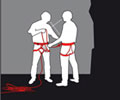
|
Stress, crowds (indoor climbing walls) and routines pose the biggest
dangers for making mistakes when tying in or inserting the protection.
Deadly falls have happened because climbers have tied on to the gear
loops. That is why a routine partner check helps. Take half a minute
to check yourself and your partner: are all buckles closed? Tied on
correctly? Knots tight enough? Safety devices clipped on properly? Carabiners
locked? Have fun! Safe climbers always keep an eye on their partner to make sure he or she is paying attention. This is how trust and strong partnerships are formed in the mountains… |
| Fall training | |
| It does not matter how far you fall: a Mammut harness will never let you down. But falling has to be learned. Practice the right «falling techniques» in a gym or on a safe route, so that you do not have a fear of falling and will react correctly should it come to the crunch. | |
| Preparation | |
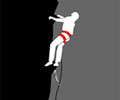
|
For your fall training choose a quiet, nice place with enough space for your belay partner and also good safety points (e.g. indoor climbing wall, solid bolts). For your first attempts at a fall you need a «fall friendly» site: vertical or slightly overhanging without the danger of hitting anything. When falling, make sure you have enough distance from the ground and give yourself more than enough fall height (you always drop further than you think). |
| Fall | |
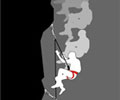
|
Push yourself gently away from the wall on all fours, so that you do not slide along it, but also don’t crash into it by doing a big arc; you can practice when you are top roping (jump down with a slightly slack rope). Make sure you are in the right «flight position»: upright, tight stomach muscles, slightly bent over, legs slightly apart and towards the front, knees slightly bent, both hands holding the rope at the tie-in knot. At the moment of braking let the rope go and the impact on the wall is evenly caught on all fours. |
| Belay training | |
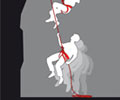
|
Fall training is also belay training for your partner: Through «soft belaying» he reduces the impact. He goes into a slight crouch and then stands up straight to hold the fall; heavier belay partners have to actually jump in the air. For lighter belay partners (about 20 kg+ difference) we recommend anchoring the belayer. |






